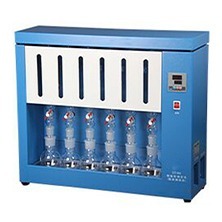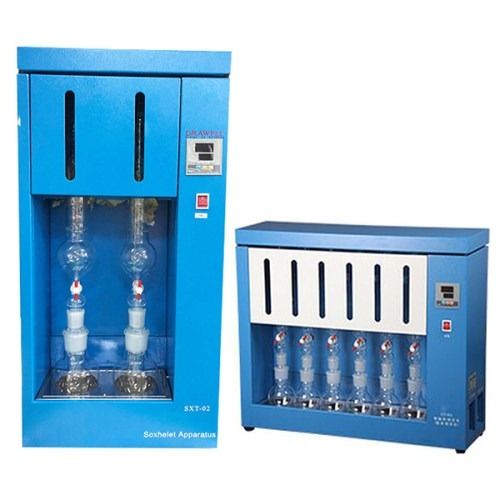Soxhlet extraction is a popular method for continuously extracting a target component from a solid sample. It is accomplished by employing a specialized Soxhlet extraction apparatus known as a Soxhlet extractor, which is comprised of a round-bottom flask, a condenser, and a thimble.

Overview of the Soxhlet Extraction Process
It is crucial to note that the Soxhlet extraction process can be time-consuming and requires careful temperature, solvent selection, and extraction time control to maximize extraction efficiency.
1. Prepare sample
The solid sample containing the target component is coarsely powdered or otherwise prepared to increase its surface area and facilitate extraction.
2. Assemble soxhlet extractor
The Soxhlet extractor is built by inserting the thimble (typically made of cellulose or glass) containing the solid sample into the Soxhlet apparatus’s round-bottom flask. The flask is linked to a condenser, which is cooled by a water source.
3. Add solvent
A suitable extraction solvent, normally enough to cover the solid sample, is added to the flask. To allow for efficient extraction, the solvent should have a lower boiling point than the target material.
4. Begin extraction
The extraction begins by heating the flask, which causes the solvent to vaporise and rise through the thimble. The solvent condenses in the condenser and drops back into the flask, resulting in a continuous flow of solvent across the sample.
5. Extract substance
The solvent selectively dissolves the target ingredient from the solid sample as it circulates through the sample. The solvent transports the dissolved chemical back into the flask, while the solid residue remains in the thimble.
6. Repeat extraction cycles
Typically, the extraction procedure is repeated several times, with the solvent constantly flowing through the sample and removing the target component. The number of cycles required is determined by the desired amount of extraction as well as the qualities of the target chemical.
7. Collect extract
Once the extraction procedure is complete, the extracted substance, which is dissolved in the solvent in the flask, is collected in a separate container. Depending on the requirements and applications, this extracted material may be further treated, purified, or analyzed.
8. Evaporate the solvent
If necessary, the collected extract can be evaporated to eliminate the solvent and concentrate the recovered material. This can be accomplished through the use of techniques such as rotary evaporation or freeze drying.
9. Analyze and characterize the extract
To assess its identification, purity, and quality, the extracted substance can be analyzed and characterized using various techniques such as spectroscopy, and chromatography.
10. Clean and disassemble equipment
After the extraction is finished, the Soxhlet apparatus and associated extraction equipment should be thoroughly cleaned and maintained for future use.

Key Components of a Soxhlet Extractor
- Round-bottom flask
The round-bottom flask is the main vessel of the Soxhlet extractor, where the solid sample and extraction solvent are put. It is normally made of glass and is intended to endure high temperatures and pressure during the extraction process.
- Thimble
The thimble is a tiny cylindrical container, usually made of cellulose or glass, in which the solid sample to be extracted is held. The thimble, which is put inside the round-bottom flask, allows the extraction solvent to circulate through the sample while keeping the solid residue from escaping into the flask.
- Condenser
The condenser is a glass tube or coil linked to the round-bottom flask and used to return the vaporized solvent to liquid form. It is usually connected to a water source for cooling, which aids in the condensing of the solvent and its return to the round-bottom flask in a continuous extraction cycle.
- Heating source
A heating source, such as a hotplate or a mantle, is used to heat the round-bottom flask and vaporize the solvent to begin the extraction process. Throughout the extraction process, the heating source should be capable of maintaining a constant temperature.
- Cooling source
To cool the condenser and condense the solvent vapor back into liquid form, a cooling source such as tap water or a circulating chiller is utilized. This helps to keep the solvent flowing through the sample and allows for more efficient extraction.
- Collection flask
The extracted substance is collected in a separate flask or container, which is dissolved in the solvent and transported back into the round-bottom flask by the condenser. The collection flask is normally situated at the condenser’s end and collects the solvent and extracted substance as it condenses.
- Stopcock
In the Soxhlet extractor, a stopcock or valve is frequently incorporated, giving control of the solvent flow and the ability to stop or change the extraction process as needed.
Proper Soxhlet extractor installation, use, and maintenance are crucial for efficient and safe extraction of the target material from the solid sample.

Various Types of Compounds Extracted Through Soxhlet Extractor
Organic compounds
The Soxhlet extractor is often used to extract organic compounds from solid samples, such as natural products, flavors, perfumes, and contaminants. Depending on the polarity and solubility of the target molecule, organic solvents such as ethanol, methanol, dichloromethane, and hexane are frequently employed as extraction solvents.
Essential oils
Essential oils are extracted by Soxhlet extraction from plant materials such as herbs, spices, and flowers. Because of their scent, flavor, and therapeutic characteristics, essential oils are widely employed in the culinary, cosmetic, and pharmaceutical industries.
Lipids
Fats and oils are derived from solid samples such as plant seeds, animal tissues, and food products. Soxhlet extraction is a typical method for lipid extraction in research and industry since lipids are vital for nutritional, functional, and industrial uses.
Environmental pollutants
Persistent organic pollutants (POPs), insecticides, and polycyclic aromatic hydrocarbons (PAHs) are examples of contaminants found in soil, sediment, and other environmental samples. To evaluate the amounts of these pollutants in environmental samples, Soxhlet extraction is frequently employed in environmental analysis and monitoring.
Pharmaceuticals
Active pharmaceutical ingredients (APIs) can be extracted from solid dosage forms such as tablets and capsules using a Soxhlet extractor for analysis or formulation. Soxhlet extraction can also be utilized to create medicine delivery systems like controlled-release formulations.
Natural products
Natural products derived from plant materials include alkaloids, flavonoids, and terpenoids for medical and phytochemical research.
Polymers
Soxhlet extraction is commonly used in polymer extraction to recover low molecular weight molecules, residual monomers, and other contaminants. This has the potential to be beneficial in polymer characterization and quality control.
Summary
A Soxhlet extraction apparatus is an effective method to extract the target component from a solid sample. The extracted component then settles in the flask’s solvent, where it can be collected for further examination or processing.

